 Ladybugs and Asian Lady Beetles may seem like similar insects at first glance, but a closer look reveals distinct differences that are worth exploring. From their physical characteristics to their behavior and ecological roles, understanding the disparities between these two species offers fascinating insights into the world of beetles. In this blog post, we'll delve into the nuances that set ladybugs and Asian lady beetles apart, shedding light on their unique traits and dispelling common misconceptions along the way.
Ladybugs and Asian Lady Beetles may seem like similar insects at first glance, but a closer look reveals distinct differences that are worth exploring. From their physical characteristics to their behavior and ecological roles, understanding the disparities between these two species offers fascinating insights into the world of beetles. In this blog post, we'll delve into the nuances that set ladybugs and Asian lady beetles apart, shedding light on their unique traits and dispelling common misconceptions along the way.
Why Are Ladybugs and Asian Lady Beetles Often Mistaken for One Another?
Ladybugs (Coccinellidae) and Asian lady beetles (Harmonia axyridis) are frequently mistaken for one another due to several overlapping physical characteristics and behaviors. Both insects belong to the beetle order Coleoptera and share a similar body shape and size, typically ranging from about 5 to 8 millimeters in length. They both possess distinctive domed bodies with round, convex shapes, often adorned with black spots on a red or orange background. This resemblance in appearance can lead to confusion, especially for individuals unfamiliar with entomology or those encountering these insects casually.
One of the primary reasons for the confusion between ladybugs and Asian lady beetles lies in their shared ecological niche and habitat preferences. Both species are beneficial predators in gardens and agricultural settings, where they play crucial roles in controlling aphids, scale insects, and other pest populations. As a result, they are often encountered in similar environments, such as gardens, crop fields, and wooded areas, further blurring the distinction between them for casual observers.
 Moreover, ladybugs and Asian lady beetles exhibit comparable behaviors, adding to the difficulty in distinguishing between them. Both species are known to aggregate in large numbers, particularly during the fall months when they seek shelter for overwintering. This behavior can lead to massive swarms of beetles congregating on buildings, trees, and other structures, creating the impression of a single species rather than two distinct ones. Additionally, both ladybugs and Asian lady beetles emit a yellowish fluid, known as reflex blood, when disturbed, which serves as a defense mechanism against predators. This shared defensive strategy can further contribute to the misconception that they are the same species.
Moreover, ladybugs and Asian lady beetles exhibit comparable behaviors, adding to the difficulty in distinguishing between them. Both species are known to aggregate in large numbers, particularly during the fall months when they seek shelter for overwintering. This behavior can lead to massive swarms of beetles congregating on buildings, trees, and other structures, creating the impression of a single species rather than two distinct ones. Additionally, both ladybugs and Asian lady beetles emit a yellowish fluid, known as reflex blood, when disturbed, which serves as a defense mechanism against predators. This shared defensive strategy can further contribute to the misconception that they are the same species.
What Are The Key Differences Between Ladybugs and Asian Lady Beetles?
Ladybugs and Asian lady beetles, often confused due to their similar appearance, are distinct species with notable variations in traits and behaviors. A primary difference lies in their coloration and markings: ladybugs typically exhibit bright red or orange wing covers adorned with black spots, serving as a warning to predators of their unpalatability. Conversely, Asian lady beetles display a broader range of colors, including orange, red, yellow, and occasionally black, with variable spot patterns, complicating their differentiation, particularly for those lacking expertise in entomology.
 Moreover, the species diverge significantly in behavior and habitat preferences. Ladybugs are commonly found in gardens and agricultural fields, where they serve as efficient predators of aphids and other plant pests, earning them favor among gardeners and farmers. In contrast, Asian lady beetles possess a broader dietary range, consuming not only aphids but also various insects, fruits, and pollen. However, their tendency to invade homes in large numbers during fall, seeking shelter from impending cold weather, often results in nuisance infestations, frustrating homeowners.
Moreover, the species diverge significantly in behavior and habitat preferences. Ladybugs are commonly found in gardens and agricultural fields, where they serve as efficient predators of aphids and other plant pests, earning them favor among gardeners and farmers. In contrast, Asian lady beetles possess a broader dietary range, consuming not only aphids but also various insects, fruits, and pollen. However, their tendency to invade homes in large numbers during fall, seeking shelter from impending cold weather, often results in nuisance infestations, frustrating homeowners.
Further disparities arise in their reproductive habits and lifecycles. Ladybugs typically deposit eggs beneath leaves near aphid colonies, ensuring ample food for hatching larvae. These larvae undergo multiple molts before pupating and emerging as adults. In contrast, Asian lady beetles lay eggs on diverse surfaces, with their larvae displaying cannibalistic tendencies, consuming unhatched eggs and smaller larvae. Such differences in reproductive strategies carry implications for population dynamics and ecological interactions between the species.
Additionally, while both species share a characteristic hemispherical body shape and belong to the Coccinellidae family, they diverge taxonomically, with ladybugs classified under the genus Coccinella and Asian lady beetles under Harmonia. This taxonomic distinction underscores their evolutionary divergence and emphasizes the intricate biodiversity within the beetle family.
 In summary, while ladybugs and Asian lady beetles share superficial resemblances, closer examination reveals significant differentiations in appearance, behavior, habitat preferences, and reproductive strategies. Understanding these distinctions enhances appreciation for beetle diversity and their ecological significance in ecosystems.
In summary, while ladybugs and Asian lady beetles share superficial resemblances, closer examination reveals significant differentiations in appearance, behavior, habitat preferences, and reproductive strategies. Understanding these distinctions enhances appreciation for beetle diversity and their ecological significance in ecosystems.
Are Ladybugs or Asian Lady Beetles Harmful to Humans?
Ladybugs are generally considered beneficial insects due to their role as natural predators of aphids and other garden pests. They are harmless to humans and do not pose any direct threat. In fact, many people welcome them in their gardens as a form of natural pest control.
 On the other hand, Asian lady beetles, while closely resembling ladybugs, can sometimes be more troublesome for humans. These beetles were introduced to North America as a biological control agent to manage aphid populations. However, they have become invasive in some regions and can be a nuisance when they invade homes in large numbers during the fall months in search of shelter for the winter. While they do not bite or sting, Asian lady beetles can release a foul-smelling yellow fluid when disturbed, which can cause irritation to the skin and eyes for some individuals. In rare cases, they may trigger allergic reactions in sensitive individuals.
On the other hand, Asian lady beetles, while closely resembling ladybugs, can sometimes be more troublesome for humans. These beetles were introduced to North America as a biological control agent to manage aphid populations. However, they have become invasive in some regions and can be a nuisance when they invade homes in large numbers during the fall months in search of shelter for the winter. While they do not bite or sting, Asian lady beetles can release a foul-smelling yellow fluid when disturbed, which can cause irritation to the skin and eyes for some individuals. In rare cases, they may trigger allergic reactions in sensitive individuals.
Another notable difference is in their behavior. Ladybugs are more solitary insects, while Asian lady beetles tend to aggregate in large numbers, especially when seeking shelter. This clustering behavior can exacerbate the nuisance they pose to humans, as it increases the likelihood of large infestations in homes and other structures.
In summary, while ladybugs are generally harmless and even beneficial to humans, Asian lady beetles can sometimes be a nuisance, particularly when they invade homes in large numbers. However, neither species poses a significant threat to human health, and their presence is often more of an annoyance than a danger.
Can I prevent ladybugs or asian lady beetles in my home?
 Preventing ladybugs or Asian lady beetles from entering your home can be challenging, but there are several strategies you can employ to minimize their presence. Ladybugs and Asian lady beetles are attracted to warmth and light, especially during the fall months when they seek shelter for the winter. Here are some steps you can take to deter them:
Preventing ladybugs or Asian lady beetles from entering your home can be challenging, but there are several strategies you can employ to minimize their presence. Ladybugs and Asian lady beetles are attracted to warmth and light, especially during the fall months when they seek shelter for the winter. Here are some steps you can take to deter them:
- Seal Entry Points: Inspect your home for any cracks, gaps, or openings where ladybugs or Asian lady beetles could enter. Seal these entry points using caulk or weather stripping to prevent their access.
- Install Screens: Make sure all doors, windows, and vents have tightly fitting screens to prevent ladybugs and other pests from entering your home while still allowing for ventilation.
- Use Light Color Exterior: Ladybugs are attracted to light-colored buildings, so consider painting your home in darker shades to make it less appealing to them.
- Remove Attractants: Ladybugs are drawn to certain scents, including sweet-smelling flowers and fruit. Keep outdoor garbage cans tightly sealed and promptly clean up any fallen fruit or vegetation in your yard.
- Reduce Moisture: Ladybugs are also attracted to moisture, so repair any leaks in your home and ensure proper drainage around your property to reduce damp areas where they might congregate.
- Natural Repellents: Certain plants, such as chrysanthemums, marigolds, and garlic, are believed to repel ladybugs. Planting these around the perimeter of your home may help deter them.
- Professional Pest Control: If you have a persistent ladybug or Asian lady beetle infestation, consider hiring a professional pest control service. They can assess the situation and implement targeted solutions to address the problem effectively.
While it may be challenging to completely prevent ladybugs or Asian lady beetles from entering your home, implementing these preventive measures can significantly reduce their presence and minimize any potential nuisance they may cause.
Can EcoShield Pest Solutions help prevent ladybugs and asian lady beetles?
Yes! EcoShield Pest Solutions can help in preventing infestations of ladybugs and Asian lady beetles through the Shield Home Protection Plan’s comprehensive pest control services. By employing eco-conscious and targeted approaches, such as sealing entry points, applying insecticides approved by the National Pest Management Association, and implementing preventive measures, EcoShield can effectively deter these pests from infiltrating homes or businesses. EcoShield Pest Solutions offers a reliable means to safeguard against unwanted invasions of ladybugs and Asian lady beetles, ensuring peace of mind for homeowners.